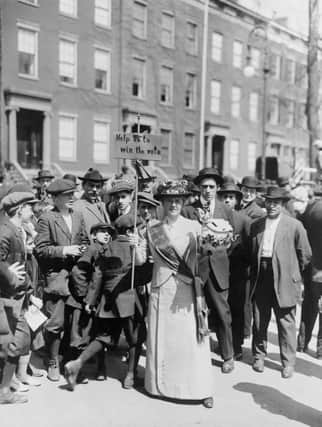What was a suffragette?


Before 1918 women had almost no role in British politics – they didn’t even have the right to vote.
A woman’s role was domestic, encompassing little outside having children and taking care of the home. The suffragettes changed this.
Advertisement
Hide AdAdvertisement
Hide AdThe 19th century was an era of massive change. The Industrial Revolution and numerous reforms, including the abolition of slavery in 1833, saw society changed forever. Women did see some progress – in 1859 the first female doctor was registered, in 1878 women could graduate from university, and in 1882 women were allowed to keep inherited property and wages. But they still couldn’t vote.
TIMELINE
1832Mary Smith presented the first women’s suffrage petition to Parliament1866A women’s suffrage committee was formed in London1867Lydia Becker founded the Manchester National Society for Women’s Suffrage1897National Union of Women’s Suffrage Societies (NUWSS) was founded1903Emmeline Pankhurst was arrested, tried andimprisoned on a number of occasions over the next decade1907Women’s Freedom League founded by Charlotte Despard and TeresaBillington-Grieg1909Hunger strikes and force-feeding began1914First World War begins and WSPU and NUWSS cease campaigning1918Representation of the People Act passed allowing men over 21 and women over 30 to vote.1919Nancy Astor is the first female MP to sit in the House of Commons1928Representation of the People Act is amended and allows everyone over the age of 21 to vote1970Equal Pay Act – men and women get the same wage for same job
Campaigns for women’s rights, including the right to vote, started around the mid-19thcentury, after Mary Smith delivered the first women's suffrage petition to parliament in 1832.
But it wasn’t really until 1897, when Millicent Fawcett founded the National Union ofWomen’s Suffrage Societies, that the campaign for women’s suffrage really gainedmomentum.
Advertisement
Hide AdAdvertisement
Hide AdThese campaigners were known as suffragists and they believed debate, petitions andpeaceful protest were the keys to success. But the suffragists failed to get results, and manycampaigners decided a more militant approach was required.
In 1903 Emmeline Pankhurst, and her two daughters Christabel and Sylvia, set up theWomen’s Political and Social Union in Manchester with its slogan ‘deeds not words’. These women became known as suffragettes and soon made headlines up and down the country.
Suffragettes were a shock to Edwardian society. They interrupted political meetings, chainedthemselves to railings, yelled while waving banners emblazoned with ‘VOTES FORWOMEN’, were regularly arrested, went on hunger strike, cut phone lines and one, EmilyDavidson, even threw herself under a horse to get the suffragette message heard.
But the suffragettes’ fight paid off. In 1918, the Representation of the People Act waspassed, giving women over the age of 30, and who owned a certain amount of property, theright to vote. It would be a further 10 years until the vote was extended to all women, whenthe Equal Franchise Act was passed, but it was a major step in the right direction.
Amnesty International are searching for 'modern Suffragettes'
Advertisement
Hide AdAdvertisement
Hide AdTo nominate an amazing woman your local area, please visit www.amnesty.org.uk/suffragettespirit. All women must have carried out work to help others in their local area within the last 10 years. All successful nominees will be contacted to give consent prior to being placed on the Suffragette Spirit Map of Britain. This campaign has been funded by People’s Postcode Lottery.